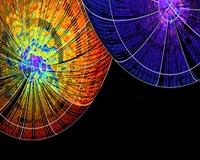 |
Washington (AFP) March 1, 2010 A US radar that launched into space aboard an Indian spacecraft has detected craters filled with ice on the moon's north pole, NASA scientists said Monday. The US space agency's Mini-SAR radar found more than 40 small craters ranging in size from one to nine miles (1.6 to 15 kilometers), each full of water ice. "Although the total amount of ice depends on its thickness in each crater, it's estimated there could be at least 600 million metric tons of water ice," NASA said in a statement. The finding came weeks after President Barack Obama put on ice US ambitions to return astronauts to the moon. The lightweight, synthetic aperture radar's findings "show the moon is an even more interesting and attractive scientific, exploration and operational destination than people had previously thought," said Paul Spudis, lead investigator of the Mini-SAR experiment at the Lunar and Planetary Institute in Houston, Texas. The Mini-SAR has spent the last year mapping the moon's permanently-shadowed polar craters that are not visible from Earth, using the polarization properties of reflected radio waves. "After analyzing the data, our science team determined a strong indication of water ice, a finding which will give future missions a new target to further explore and exploit," said Jason Crusan of NASA's Space Operations Mission Directorate in Washington. The radar's findings, to be published in the journal Geophysical Research Letters, are consistent with findings of other NASA instruments and add to the growing scientific understanding of the multiple forms of water found on the moon. NASA's Moon Mineralogy Mapper, which was also on board Chandrayaan-1, has discovered water molecules in the moon's polar regions, while water vapor was detected by NASA's Lunar Crater Observation and Sensing Satellite, or LCROSS. Indian scientists reported last year in papers published in the journal Science that they had analyzed light waves detected by NASA-made instruments on board the Indian satellite and two US probes, and determined that they showed there was water on the surface of the moon. Until then, scientists had advanced the theory that except for the possibility of ice at the bottom of craters, the moon was totally dry.
Share This Article With Planet Earth
Related Links Mars News and Information at MarsDaily.com Lunar Dreams and more
 NASA Radar Finds Ice Deposits At Moon's North Pole
NASA Radar Finds Ice Deposits At Moon's North PoleWashington DC (SPX) Mar 02, 2010 Using data from a NASA radar that flew aboard India's Chandrayaan-1 spacecraft, scientists have detected ice deposits near the moon's north pole. NASA's Mini-SAR instrument, a lightweight, synthetic aperture radar, found more than 40 small craters with water ice. The craters range in size from 1 to 9 miles (2 to15 km) in diameter. Although the total amount of ice depends on its thickness i ... read more |
|
| The content herein, unless otherwise known to be public domain, are Copyright 1995-2010 - SpaceDaily. AFP and UPI Wire Stories are copyright Agence France-Presse and United Press International. ESA Portal Reports are copyright European Space Agency. All NASA sourced material is public domain. Additional copyrights may apply in whole or part to other bona fide parties. Advertising does not imply endorsement,agreement or approval of any opinions, statements or information provided by SpaceDaily on any Web page published or hosted by SpaceDaily. Privacy Statement |